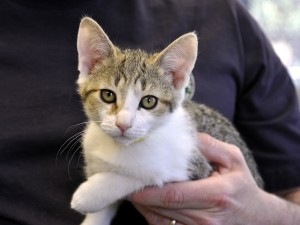The night is peaceful but in the kitten’s comfy pile of freshly washed laundry, the kitten is twitching. She jerks as she attempts to sleep, then shakes her head for the thousandth time. Constant skritch-scratching in her ears is driving her insane. The itching is nearly torturous. Her back leg thumps as she scratches once again, trying to relieve the sensation yet instead creates dual wounds beneath her ears from her sharp, baby claws. Her dreams fill with images of creepy crawlies in her ears.
 Suddenly she awakens and dashes from her bed and climbs up the bed-sheet to reach her new mom, the little blonde girl who picked her out of the litter and cuddled her all day. The kitten likes the little girl. The girl smells sweet and she was fun to play with. The kitten clambers over the covers and curls up on the little girl’s pillow, hoping the new sleeping place will ease her discomfort.
Suddenly she awakens and dashes from her bed and climbs up the bed-sheet to reach her new mom, the little blonde girl who picked her out of the litter and cuddled her all day. The kitten likes the little girl. The girl smells sweet and she was fun to play with. The kitten clambers over the covers and curls up on the little girl’s pillow, hoping the new sleeping place will ease her discomfort.
Our poor little kitten is suffering from a common, and what only be called disgusting!, ailment: ear mites.
Otodectes Cynotis, spider-like mites in the Phylum Arthropoda that can only been seen under magnification, are otherwise known as ear mites.
They cause extreme itching, coffee-ground like debris in the ears, inflammation, irritation, self-induced trauma and secondary infections.
They feed on the skin cells and wax of the ear canal, although can live in other regions as well. Some reports indicate that nearly 50% of kittens are exposed to and/or have ear mites. As a veterinarian, I often find these ugly creatures and point out the black-brown ear debris to owners, only to be informed, “Oh yah, I have to clean her ears every day. That’s just dirt.” No, I’m afraid to tell you, it is not dirt.
It is a mite infestation, and it is highly contagious and completely yucky!
Thankfully, they are easily treated. Ivermectin topical treatments like Acarexx are my favorite, but several other topical brands are available. There is a vast difference in efficacy and speed of treatment between OTC products and prescription products.
There are home remedies that can be effective including mineral oil, other oils and some powders, but the risk of incomplete killing is relatively high, and multiple treatments may be needed, thereby allowing egg development and recurrence.
Some skin topical treatments are also labeled to kill the pesky creatures, such as Revolution. Simple ear cleaning WILL NOT cure them, as it only takes a few microscopic eggs or mites left behind to re-start the life cycle. Once treated, they should not recur unless your cat gets in contact with another cat with mites.
Therefore, I recommend treating all cats in a household for mites if they are diagnosed in one. However, as a note of caution, ear mites can cause additional bacterial or yeast infections which are treated quite differently, thus it is important to have them accurately diagnosed by your veterinarian and not just treat any visible ear debris with strong medications that can, like any medications, cause side effects. In addition, your veterinarian may need to treat your kitten with multiple medications.
And the little blonde girl with the mite infested kitten curled up on her pillow? She should be safe, as cat ear mites like cats, not humans, and are not contagi
